Two, Two, Two Cars in One
As a plug-in hybrid, the 2017 Ford Fusion Energi is essentially two cars in one—a battery electric vehicle and a hybrid vehicle. Driving in EV mode, the Energi performed quite well. Thanks to the instant-on torque from the electric motor, acceleration was rather brisk when needed, but that action can devour electrons rapidly. It cruised city streets in quiet fashion and easily keeps up with the flow of traffic. Considering the 38-psi inflation pressures for the P235/50R-17 low-rolling resistant tires, the ride was quite smooth.
With the Fusion, Ford brought to its American buyers the same world-class road manners that overseas owners of the Mondeo have long enjoyed. While most hybrids drain the fun out of driving, the Fusion Energi has responsive steering, a nimble chassis and taut body control that make for an enjoyable drive. You can hustle the car down a back road and actually get a smile on your face. The all-independent suspension provided a compliant feel that makes it ideal for long trips as well as daily commuting.
The Fusion Hybrid History
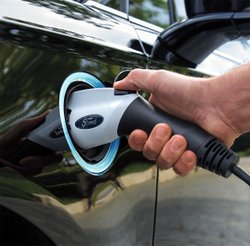
As part of its commitment to sell a broader selection of fuel-saving hybrid and electric-powered vehicles, Ford launched the 2013 no-plug Fusion Hybrid and plug-in Fusion Energi. Since then, Chevrolet’s Volt is the plug-in hybrid sales leader by far, but the Fusion Energi has second place locked in. Ford sold 15,938 Fusion Energis in 2016, a whopping 63.5 percent increase over 2015.
Attribute the increase to a freshened 2017 Fusion lineup and a consumer buying trend that enabled a best-ever annual sales result for plug-in vehicles in 2016, though that ended up as less than one-half of one percent of the 17.5 million unit market.
For 2017 Ford not only gave the Fusion new looks for the exterior and interior, but also added a new luxury Platinum model as well as giving the car a slight increase in electric driving range and an increase for the combined gasoline and electric range.
The 2017 Ford Fusion Energi’s pricing starts at $33,995 for the SE, $34,995 for the Titanium trim, and $41,995 for the new loaded Platinum model. Those prices average about $4,000 to $5,000 higher than those of the non-plug-in Fusion Hybrid, but local and national EV incentives can narrow the gap or, in some regions, even eliminate the price differential altogether.
EPA ratings for the 2017 Fusion Energi when using both gasoline and electric power are 95 MPGe city/81 MPGe highway/88 MPGe combined. (MPGe, or Miles Per Gallon Equivalent, measures the distance a car can travel electrically on the same amount of energy as in one gallon of gasoline.) The total electric range is 22 miles, a boost from 20 miles last year.
When operating as a hybrid, once battery energy has been depleted, the Energi is rated at 42 mpg combined, earning it a spot in Clean Fleet Report’s 40 MPG Club. That compares to the 38 mpg combined rating for the 2016 model.
The car’s combined gasoline and electric driving range has risen to 610 miles from last year’s 550 miles. To that I will tip my hat to anyone who can drive more than 600 miles without stopping.
Ford’s Hybrid System
The 2017 Fusion Energi and the less-electrified Fusion Hybrid both employ a lean-burning Atkinson-cycle 2.0-liter four-cylinder engine. Without delving into details, an Atkinson-cycle engine gives up a little power output in exchange for improved fuel efficiency and reduced emissions.
Ford says the four’s output is 141 horsepower and 129 pounds-feet of torque. Working in conjunction with the engine is a 118 horsepower AC electric traction motor that supplies 117 pounds-feet of torque. Since they make peak power in different ways, total system output adds up to only 188 horsepower.
Ford’s hybrid system is a powersplit architecture design. In a powersplit hybrid, the gasoline engine and electric motor can work together in blended mode or individually to maximize efficiency.
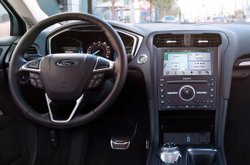
The engine also can operate independently of vehicle speed, providing power to the wheels or charging the batteries via regenerative braking as needed. The motor alone can deliver enough power to the wheels to silently whisk the Fusion Energi to a speed of 85 mph or be driven up to 22 miles on electric power alone.
Ford attributes the 2017 fuel economy increase to changes in the car’s powertrain control software and regenerative braking algorithms.
A planetary gear set transmits power output of the engine, motor or the combination of both to an electronically controlled continuously variable transmission (ECVT) that directs the power to the front wheels.
The Fusion Energi exchanges the standard hybrid’s 1.4-kilowatt-hour (kwh) lithium-ion traction battery pack with a much larger, 7.6-kwh battery pack located in the cargo area. The battery provides the juice for electric propulsion and draws its charge on the go from a second motor/generator driven by the engine and from regenerative braking. Using a standard 120-volt outlet, recharging a depleted battery takes seven hours. Thus, there are no overnight charging worries with just a wall outlet. From a 240-volt Level 2 charger the Energi can be fully charged in 2.5 hours.
Still A Pacesetter For Artsy Design
The Fusion is essentially a Ford Mondeo sold in European markets, with styling penned by Ford’s European design group. Five years into it, the Fusion’s bold aerodynamic styling still looks fresh.
For 2017, Ford gave the Fusion its most significant update since its model-year 2013 redesign. The already handsome nose has a wider and more angular grille flanked by new LED headlamps that sweep gracefully into muscular front fenders. The hood and front-fender sheet metal is unchanged, while thin roof pillars and a slopping roofline suggest a sense of lightness. On the backside, the deck lid has been lowered and features LED taillamps.
The only attribute that distinguishes the Energi from its non-plug sibling is the round “filler door” on the left front fender. A four-element LED light ring surrounds the perimeter of the charging port, lighting up in segments as a visual cue to let the driver know the battery’s charge status upon parking the vehicle and plugging it in.
The Inside Story
Hybrid specific energy and powertrain data is provided by a center eight-inch screen, and dual 4.2-inch LCD screens on either side of the center instruments. Included is Ford’s latest version of EcoGuide, which helps drivers maximize fuel economy though a series of novel interactive displays. To prevent sensory overload, the system allows the driver to decide how much information to see, and what can be ignored.
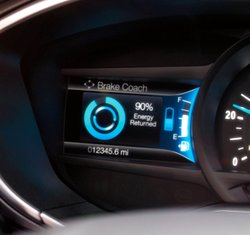
My favorite feature is the clever Brake Coach; Ford has filed patents for the algorithm and display function. It coaches the driver in a manner that maximizes the energy returned to the battery pack through regenerative braking — brake early and lightly.
Ford has done a commendable job with the Fusion Energi’s interior. The mostly leather cabin of our Platinum test car with its metal accents gave a true luxury feel. The touch points are soft and every inch of the cabin uses high-quality materials that projected the high-end look and feel.
The conventional center-console-mounted transmission lever is replaced with a rotary dial that you turn to select a gear. Accompanied by a neat little lever to operate the electric parking brake, it’s a clean, contemporary arrangement and makes it easier to reach the console’s bins and cupholders.
Front quilted leather seats were firm, yet comfortable and infinitely adjustable. Rear seating can accommodate three adult passengers with good legroom, although the rear sloping roof cuts into headroom. It shouldn’t be a deal breaker.
As a family car, what could be a deal breaker is the small trunk. The large battery limits cargo space to just 8.2 cubic feet—four cubic feet less than the hybrid version and nearly half of what’s available on standard Fusions.
Ford’s Sync 3 infotainment system with navigation, standard on Energi models, synced up easily with my iPhone and was intuitive as I negotiated my way through entertainment, climate control,
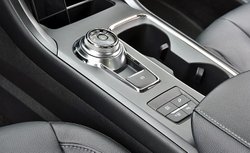
navigation and communication screens. The system enables Apple CarPlay, Android Auto, 4G LTE and other essential apps. Siri will help iPhone users retrieve maps and messages should they prefer not to use the touchscreen.
The new Fusion Energi beefs up its tech arsenal, which now features adaptive cruise control, automatic collision-avoidance braking, lane-keeping assist, lane-departure warning and features automatic parking.
Driving The Fusion Energi
As I said, the Fusion Energi is essentially two cars in one—a battery electric vehicle and a hybrid vehicle. The acceleration was rather brisk when needed, but it also cruised city streets quietly and easily kept up with the flow of traffic. The ride was quite smooth.
When the battery charge depleted, the hybrid powertrain delivered more than sufficient acceleration to give it enough oomph to quickly merge onto freeways, and passing on two-lane highways was accomplished with ease. The transition from electric drive to the engine was a non-event, such that I often had to look at the instrument panel to confirm the car had switched to gasoline power.
With the Fusion, Ford brought the European Mondeo, giving the Fusion Energi responsive steering, a nimble chassis and taut body control that make for an enjoyable drive. The all-independent suspension provided a compliant feel that made it ideal for long trips as well as daily commuting.
During our week with the Energi we clocked 359 miles, which were tallied on city streets, two lane highways and freeways. The fuel economy readout indicated 44.3 mpg, slightly more than two mpgs better that the EPA number. As for electric driving range, with a fully charged battery the car was nearly spot on with 21.7 miles before the juice ran out. The readout display indicated 99.3 MPGe, again better than the EPA estimate.
In The Market Place
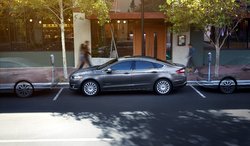
Competition among plug-in hybrid vehicles was scarce when the Fusion Energi arrived; it’s not anymore. In addition to the Chevrolet Volt with a class-topping 53-mile driving range, direct competitors now include plug-in hybrid versions of the Hyundai Sonata, Kia Optima, Honda’s Accord and the Toyota Prius Prime.
While the Hyundai Sonata and Kia Optima and Honda Accord plug-ins are four-door sedans, the Chevy Volt and Prius Prime are five-door hatchbacks.
If you can live with four functional seats rather than five, the Chevy Volt boasts more than twice the electric driving range of the Energi. Similarly, if cargo space and overall efficiency is more important than all-electric range, then the Prius Prime might be the best choice. The Accord Plug-in compares the closest to the Fusion with a plug. It’s more expensive than the Ford, but has better fuel economy.
All things considered, though, the 2017 Ford Fusion Energi is an excellent green-oriented family hauler and commuter vehicle. It also offers handsome styling, a quiet cabin, nimble chassis and smooth ride. And, if your round trip commute is around 40 or so miles with the opportunity to plug-in at work, it’s a very pleasing electric car.
Related Stories You Might Enjoy:
Road Test: 2017 Chevrolet Volt
Road Test: 2016 Chevrolet Volt
Top Ten Best-Selling High-MPG Cars
Road Test: 2017 Hyundai Sonata Plug-in Hybrid
Road Test: 2014 Ford Fusion Energi
Road Test: 2014 Toyota Prius Plug-in
Disclosure:
Clean Fleet Report is loaned free test vehicles from automakers to evaluate, typically for a week at a time. Our road tests are based on this one-week drive of a new vehicle. Because of this we don’t address issues such as long-term reliability or total cost of ownership. In addition we are often invited to manufacturer events highlighting new vehicles or technology. As part of these events we may be offered free transportation, lodging or meals. We do our best to present our unvarnished evaluations of vehicles and news irrespective of these inducements.
Our focus is on vehicles that offer the best fuel economy in their class. We also feature those that are among the top mpg vehicles in their class. In addition, we aim to offer reviews and news on advanced technology and the alternative fuel vehicle market. We welcome any feedback from vehicle owners and are dedicated to providing a forum for alternative viewpoints. Please let us know your views at publisher@cleanfleetreport.com.

10 thoughts on “Road Test: 2017 Ford Fusion Energi Plug-in Hybrid”